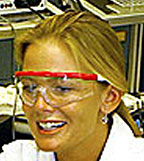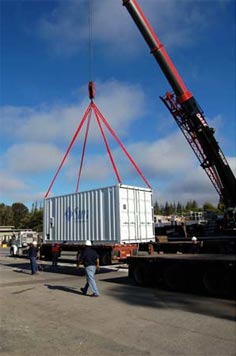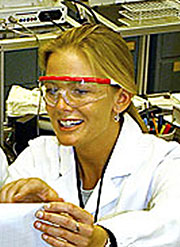| Research
|
Wynne K. Schiffer embodies the interdisciplinary tradition of DOE's Brookhaven National Laboratory. Her research in brain imaging draws on the expertise of biologists, chemists, and physicists to develop new instruments and techniques to “see” the inner workings of the brain. Her studies have led to advances in imaging technology and our understanding of human health issues such as drug addiction. Recently, Schiffer pioneered an effort to label nanoparticles — particles measuring billionths of a meter — with positron-emitting radioactive isotopes. When attached to nanoparticles, these radioactive “tags” can be used to monitor the particles' location and concentration in real time and space inside a living organism. Schiffer and her colleagues have developed ways to manipulate the nanoparticles, generating a new family of imaging probes for use with positron emission tomography (PET), a technique that has yielded many advances in the study of human disease. Schiffer has also used microPET imaging to relate changes in the brain directly to changes in behavior in animal models of drug abuse. In humans, exposure to environments or cues linked to drug abuse activates brain regions associated with attention, emotion, memory, and motivation. This is thought to underlie relapse. Using PET, Schiffer showed that presenting animals with a drug-associated environment produced a similar pattern of brain activation, providing evidence that links an animal model of relapse to the human condition. The work validates the use of “conditioned place preference” in animals as a model for drug-seeking behavior. Schiffer's research draws on her undergraduate work in psychology at Colorado College and her graduate studies in neurobiology and behavior at Stony Brook University, where she earned her M.S. and Ph.D. She takes time out from her research to address a wide range of audiences — from school kids to community groups to law-enforcement officers — about the important role of nuclear medicine in diagnosing and treating diseases such as mental illness and drug abuse.Submitted by DOE's
Brookhaven National Laboratory |
|||||||||||||||||||||||||
|
Check out the Office of Science's new Website.
|
Secretary Bodman announces Bay Area-based DOE bioenergy centerA partnership of three DOE national laboratorie—Sandia, Lawrence Berkeley, and Lawrence Livermore—and three research universities in the San Francisco Bay Area has been chosen to host one of three national bioenergy research centers, Secretary of Energy Samuel Bodman announced recently. The center will be funded by DOE through its Biological and Environmental Research Genomics: GTL research program in the Office of Science. Lawrence Berkeley National Laboratory (Berkeley Lab) will lead the new center, which will be known as the DOE Joint BioEnergy Institute (JBEI). It is expected to receive $125 million in DOE funding over its first five years. The DOE JBEI's other partners are Lawrence Livermore National Laboratory, the University of California campuses in Berkeley and Davis, and Stanford University. Plans call for the center to be headquartered in a leased building in the East Bay area, central to all partners. Initial work will take place at the West Berkeley Biocenter in Berkeley. Research at the institute will focus on biofuels — liquid fuels derived from the solar energy stored in plant biomass. Harnessing even a tiny fraction of the total solar energy available each year could meet most if not all of the nation's annual transportation energy needs. Scientific studies have consistently ranked biofuels among the top candidates for meeting large-scale energy needs, particularly in the transportation sector. However, the commercial-scale production of clean, efficient, cost-effective bio-fuels will require technology-transforming scientific breakthroughs. Researchers at the DOE JBEI intend to meet this challenge through the conversion of lignocellulosic biomass into biofuels. Lignocellulose, the most abundant organic material on the planet, is a mix of complex sugars and lignin that gives strength and structure to plant cell walls. The organization of the center will feature four interdependent science and technology divisions:
In addition to maintaining an Industry Partnership Program, research at the center will be guided by an Industry Advisory Board whose membership will come from key sectors, including feedstocks, enzymes, fuels production, biotechnology, genetics, and chemistry. Each of the member institutes of the DOE JBEI brings unique capabilities to the partnership. The national laboratory partners operate state-of-the-art scientific instrumentation and research facilities. The other two DOE Bioenergy Research Centers are the DOE BioEnergy Research Center, led by the Oak Ridge National Laboratory in Oak Ridge, Tenn., and the DOE Great Lakes Bioenergy Research Center, led by the University of Wisconsin in Madison, Wisc., in close collaboration with Michigan State University in East Lansing, Mich. For more information on DOE JBEI, visit www.jbei.org.Submitted by DOE's Sandia National Laboratories |



